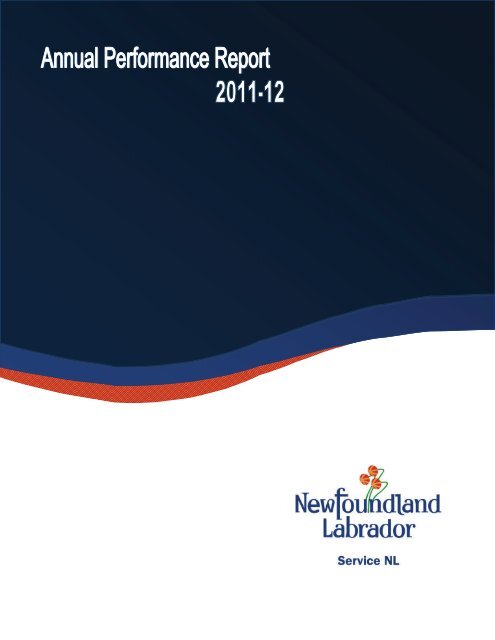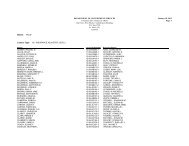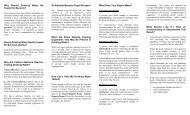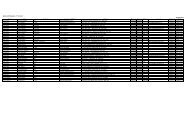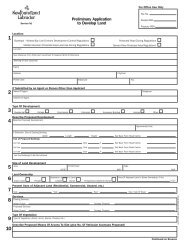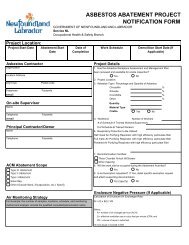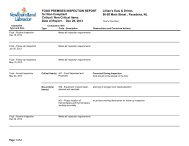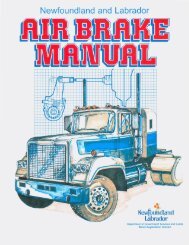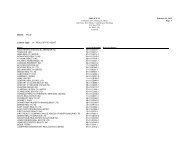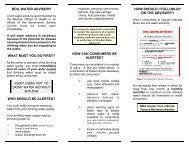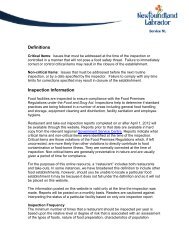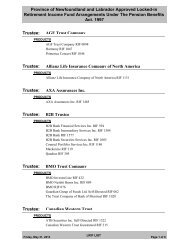Service NL Annual Performance Report 2011-12
Service NL Annual Performance Report 2011-12
Service NL Annual Performance Report 2011-12
Create successful ePaper yourself
Turn your PDF publications into a flip-book with our unique Google optimized e-Paper software.
<strong>Service</strong> <strong>NL</strong><br />
<strong>Annual</strong> <strong>Performance</strong> <strong>Report</strong><br />
<strong>2011</strong>-20<strong>12</strong>
Table of Contents<br />
Minister’s Message<br />
i<br />
Departmental Overview 1<br />
Vision 1<br />
Mission Statement 1<br />
Lines of Business 2<br />
Enforcement of Legislated Requirements 2<br />
Licensing, Permitting, Inspections and Registrations 2<br />
Conflict Resolution 3<br />
Printing <strong>Service</strong>s 3<br />
Other Key Statistics 5<br />
Number of employees 5<br />
Physical Locations 6<br />
Budget 7<br />
Ministerial Entities 7<br />
Shared Commitments 7<br />
Highlights and Accomplishments 11<br />
Outcome of Objectives 14<br />
Strategic Issue 1: Customer <strong>Service</strong> Culture 14<br />
Strategic Issue 2: Program and <strong>Service</strong> Delivery Quality and Access 16<br />
Strategic Issue 3: Legislative and Regulatory Framework 20<br />
Strategic Issue 4: Regulatory Reform 22<br />
Opportunities and Challenges 24<br />
Annex A: Ministerial Entities 26<br />
Annex B: Financial Statements 28<br />
<strong>Annual</strong> <strong>Performance</strong> <strong>Report</strong> <strong>2011</strong>-<strong>12</strong>
Message from the Minister<br />
I am pleased to submit the <strong>2011</strong>-<strong>12</strong> <strong>Annual</strong> <strong>Performance</strong> <strong>Report</strong> for<br />
<strong>Service</strong> <strong>NL</strong> in accordance with our requirements as a category one<br />
government entity under the Transparency and Accountability Act. This<br />
report details the achievements and progress made by the department this<br />
past year towards fulfilling our commitment to the strategic directions of<br />
government as outlined in our <strong>2011</strong>-14 strategic plan. My signature below<br />
is indicative of my accountability for the reported results.<br />
Fiscal year <strong>2011</strong>-<strong>12</strong> was the first year of the department’s <strong>2011</strong>-14<br />
strategic plan. Enhancing program and service delivery and improving<br />
regulatory processes are the two principal areas of focus for the<br />
department during this three-year period. As outlined in this report, the<br />
department worked collaboratively with all levels of government, industry<br />
and community partners as well as departmental public entities during the <strong>2011</strong>-<strong>12</strong> fiscal year to address our<br />
key priority issues: building a strong customer service culture, improving program and service quality and<br />
access, enhancing the department’s legislative and regulatory framework and providing leadership toward<br />
achieving more efficient government service delivery through regulatory reform.<br />
Exciting new changes as well as opportunities for the department and its clients were also made in <strong>2011</strong>-<strong>12</strong>.<br />
To implement a new vision for providing services to citizens and businesses, providing a single window of<br />
access to multiple government services, and simplifying how government connects with its clients, the former<br />
Department of Government <strong>Service</strong>s was re-branded in October <strong>2011</strong> as <strong>Service</strong> <strong>NL</strong>. Further, given the<br />
department’s existing expertise in regulatory processes, the Regulatory Reform unit of the former Department<br />
of Business was moved to <strong>Service</strong> <strong>NL</strong>. This re-branding offers a unique opportunity to reinforce government’s<br />
commitment to providing a “single-window” or “no wrong door” approach for access to government services by<br />
businesses and citizens in general. It will also strengthen the concept within government of a “citizen-centred”<br />
approach to service delivery – that is, the idea that services should be organized for the convenience of the<br />
people of the province, not on the basis of internal “silo’s” or traditional lines of business.<br />
I would like to thank departmental staff, the public and our partners for the significant progress and efforts<br />
made this past fiscal year. As minister, I look forward to continuing this success and guiding <strong>Service</strong> <strong>NL</strong> into<br />
the 20<strong>12</strong>-13 fiscal year.<br />
Paul Davis<br />
Minister<br />
<strong>Annual</strong> <strong>Performance</strong> <strong>Report</strong> <strong>2011</strong>-<strong>12</strong><br />
i
Departmental Overview<br />
<strong>Service</strong> <strong>NL</strong> delivers citizen protection services to the public in areas of public health and safety,<br />
environmental protection, occupational health and safety, consumer and financial interests and in the<br />
provision and preservation of vital events and documents. In addition, through the Office of the Queen's<br />
Printer, the department provides printing, micrographic and digital document services for Government and<br />
the general public (including copies of provincial legislation, The Newfoundland and Labrador Gazette and<br />
select documents and books). The department is also responsible for the leadership and ongoing<br />
coordination of government’s regulatory reform mandate.<br />
The department was created with the aim of consolidating, where possible, the licensing, permitting,<br />
inspection, and regulatory functions within government and providing a single-window point of access to the<br />
public for those services. The authority to carry out the department's mandate is derived from over 180<br />
statutes and regulations, as well as standards and codes of practice.<br />
The department is comprised of three branches: Government <strong>Service</strong>s Branch; Consumer and Commercial<br />
Affairs Branch; and Occupational Health and Safety Branch. A brief description of these branches can be<br />
found in the department’s <strong>2011</strong>-14 Strategic Plan, available online: http://www.servicenl.gov.nl.ca/<br />
publications/.<br />
The Minister of <strong>Service</strong> <strong>NL</strong> is also accountable for 11 public entities<br />
(Annex B) in addition to oversight of the Public Utilities Board’s<br />
mandate with respect to auto insurance and the Petroleum Products<br />
Pricing Office. The Government Purchasing Agency, the Credit Union<br />
Deposit Guarantee Corporation, the Office of the Chief Information<br />
Officer, and the Workplace Health, Safety and Compensation<br />
Commission report independently to the minister. As such, each of<br />
these entities prepares independent annual reports.<br />
Finally, under the shared services model for the delivery of Strategic<br />
Human Resources Management, the Director of Strategic Human<br />
Resources Management (SHRM) for the social sector reports to the<br />
Deputy Minister of <strong>Service</strong> <strong>NL</strong>. The social sector includes the<br />
Departments of: Education; Advanced Education and Skills; Municipal<br />
Affairs; Health and Community <strong>Service</strong>s; and <strong>Service</strong> <strong>NL</strong>. SHRM is<br />
also responsible for the Labour Relations Agency; the Government<br />
Purchasing Agency; and Fire and Emergency <strong>Service</strong>s-Newfoundland<br />
and Labrador.<br />
Vision<br />
People in Newfoundland and<br />
Labrador living and working in<br />
healthy and safe environments<br />
with access to efficient and<br />
responsive programs and services.<br />
Mission Statement<br />
By March 31, 2017, <strong>Service</strong> <strong>NL</strong><br />
will have enhanced program<br />
and service delivery through<br />
improved standards and regulatory<br />
processes that promote<br />
living and working in a healthy,<br />
fair and safe environment.<br />
A brief overview of the department’s three branches and their respective divisions and operation units are<br />
outlined in the department’s <strong>2011</strong>-14 Strategic Plan, available online: http://www.servicenl.gov.nl.ca/<br />
publications/.<br />
<strong>Annual</strong> <strong>Performance</strong> <strong>Report</strong> <strong>2011</strong>-<strong>12</strong> 1
Lines of Business<br />
<strong>Service</strong> <strong>NL</strong> is responsible for carrying out four basic lines of business through its branches and divisions,<br />
including: enforcement of legislated requirements; licensing, permitting, inspections and registrations;<br />
conflict resolution; and printing services.<br />
1. Enforcement of Legislated Requirements<br />
<strong>Service</strong> <strong>NL</strong> enforces legislated requirements in all mandated aspects of public health and safety,<br />
occupational health and safety, environmental protection, provincially-regulated financial services and<br />
consumer protection.<br />
2. Licensing, Permitting, Inspections, and Registrations<br />
<strong>Service</strong> <strong>NL</strong> provides licenses, permits, inspections and registration services at its offices around the<br />
province for the following:<br />
Public safety activities<br />
Boilers and pressure vessels, elevating devices, amusement rides, electrical installations, electrical<br />
contractors and building design for accessibility and fire/life safety.<br />
Environmental health activities<br />
Food establishments, tobacco retailers, septic and other waste water disposal systems, municipal<br />
water supplies, abattoirs, public pools, recreational facilities, daycares, personal care homes and<br />
long term care facilities, dairy farms (milk and water sampling) and housing sanitation.<br />
Environmental protection activities<br />
Waste disposal sites, spill responses, petroleum storage tank systems, sawmills, quarries, asphalt<br />
plants, scrap yards, used tire facilities, used oil storage facilities, PCB storage sites, farm waste<br />
management facilities, soil treatment facilities and illegal dumping.<br />
Provincial financial services activities<br />
Insurance, securities, pension plans, real estate, mortgage brokers and prepaid funeral services.<br />
Consumer protection activities<br />
Consumer affairs, collection agencies, private investigators and security guards, charitable gaming<br />
and residential tenancies.<br />
Commercial registrations activities<br />
Deeds, companies, personal property, co-operatives, limited partnerships, mechanics' liens,<br />
condominiums and lobbyists.<br />
<strong>Annual</strong> <strong>Performance</strong> <strong>Report</strong> <strong>2011</strong>-<strong>12</strong> 2
Occupational health and safety activities<br />
Workplaces, radiation emitting devices, asbestos abatement contractors, explosive magazines on<br />
mine sites and underground diesel equipment.<br />
Motor vehicle activities<br />
Driver licensing and vehicle registrations, highway safety-related activities, and commercial vehicle<br />
inspections (e.g. for buses, school buses and ambulances and trucks) and other highway-safety<br />
related activities.<br />
Vital statistic activities<br />
Registration and certificates for vital events, including: birth, marriage, death, legal name changes,<br />
adoptions and gender changes.<br />
Angling and small game license sales and distribution<br />
Sales to vendors and individuals. Select licensing information is also available on the department's<br />
website at www.servicenl.gov.nl.ca.<br />
3. Conflict Resolution<br />
<strong>Service</strong> <strong>NL</strong> provides conflict resolution services for disputes such as residential tenancies and specific<br />
issues related to legislative compliance with respect to the provincially-regulated financial services industry,<br />
occupational health and safety, buildings accessibility, consumer protection and public safety.<br />
4. Printing <strong>Service</strong>s<br />
<strong>Service</strong> <strong>NL</strong> provides printing, microfilming and digitizing services for government departments and agencies<br />
through the Office of the Queen's Printer. Provincial government legislation and various provincial<br />
government reports are available to the public for purchase though the Queen's Printer Bookstore, located<br />
in the East Block of the Confederation Building complex. Purchasing information and select documents,<br />
including legislation for free download, are available on the Queen's Printer web site at<br />
www.servicenl.gov.nl.ca/printer/.<br />
<strong>Annual</strong> <strong>Performance</strong> <strong>Report</strong> <strong>2011</strong>-<strong>12</strong> 3
The organizational chart below illustrates the department's reporting structure.<br />
<strong>Annual</strong> <strong>Performance</strong> <strong>Report</strong> <strong>2011</strong>-<strong>12</strong> 4
Other Key Statistics<br />
Number of employees<br />
<strong>Service</strong> <strong>NL</strong> employs 504 employees (235 men and 269 women) across the province and is comprised of<br />
three branches: the Government <strong>Service</strong>s Branch; the Consumer and Commercial Affairs Branch; and the<br />
Occupational Health and Safety Branch. Table A below provides a breakdown of departmental staff<br />
according to gender, while Table B on the following page is a map of employee distribution according to<br />
region.<br />
Table A<br />
<strong>Annual</strong> <strong>Performance</strong> <strong>Report</strong> <strong>2011</strong>-<strong>12</strong> 5
Physical Locations<br />
<strong>Service</strong>s offered by the department are available in-person through a number of office locations throughout<br />
the province, as well as through the Internet, telephone, mail, and fax. The headquarters for the<br />
department is located in the West Block of the Confederation Building complex in St. John's.<br />
The Government <strong>Service</strong> Centre Division (GSC) has five main offices - St. John's, Clarenville, Gander,<br />
Corner Brook, and Happy Valley-Goose Bay. Six other GSC offices are located in Harbour Grace, Grand<br />
Falls-Windsor, St. Anthony, Stephenville, Labrador City and Marystown. These offices provide licensing,<br />
permitting, inspection, and registration services to the public, while offices in Grand Bank, Springdale,<br />
Lewisporte and Port aux Basques serve as staff-only and private water sample drop-off locations. The Vital<br />
Statistics Division, Engineering and Inspection <strong>Service</strong>s Division, Consumer Affairs Division and Motor<br />
Registration Division also offer select services through some of the GSC sites.<br />
The Motor Registration Division<br />
delivers most of its programs<br />
and services from locations in<br />
Mount Pearl, Grand Falls-<br />
Windsor, Corner Brook, and<br />
Labrador City, as well as<br />
through regional GSC offices in<br />
Clarenville, Gander, Happy<br />
Valley-Goose Bay, and Harbour<br />
Grace. More limited MRD<br />
services are also available at<br />
Stephenville, St. Anthony, and<br />
Marystown. In addition, the<br />
Motor Registration Teleservices<br />
Centre is located in Corner<br />
Brook. There are also various<br />
driver examination satellite<br />
offices and both fixed and<br />
portable weigh scale sites<br />
throughout the province.<br />
Table B<br />
The Occupational Health and<br />
Safety Branch operates its<br />
programs from locations in<br />
Mount Pearl, Grand Bank, Grand Falls-Windsor, Corner Brook, and Wabush. The Office of the Queen's<br />
Printer/Printing <strong>Service</strong>s, Regulatory Reform Office, Commercial Registrations Division, Consumer Affairs<br />
Division, Pension Benefit Standards Division, and Financial <strong>Service</strong>s Regulation Division provide services<br />
province-wide from the St. John's area.<br />
<strong>Annual</strong> <strong>Performance</strong> <strong>Report</strong> <strong>2011</strong>-<strong>12</strong> 6
Budget<br />
The department collected $133.85 million in current account and related revenues in <strong>2011</strong>-<strong>12</strong>. The<br />
department had an operating budget of $44.89 million in <strong>2011</strong>-<strong>12</strong>, while its gross expenditures were $40.35<br />
million. These figures do not include the Government Purchasing Agency and the Credit Union Deposit<br />
Guarantee Corporation given that these entities are required to prepare and submit independent reports in<br />
accordance with the Transparency and Accountability Act. The department’s Statement of Expenditures<br />
and Revenues for the year ended <strong>2011</strong>-<strong>12</strong> is attached as Annex B.<br />
Shared Commitments<br />
<strong>Service</strong> <strong>NL</strong> has collaborative relationships with several partner departments and agencies and other<br />
stakeholders in delivering on its mandate. These relationships are essential in meeting legislative and regulatory<br />
obligations and achieving the strategic directions of government. Key partners include other<br />
provincial departments and agencies, industry, organized labour, regulatory bodies, and federal, provincial<br />
and territorial governments.<br />
Further, the department delivers many of its permitting, inspection, licensing, and enforcement services<br />
through its Government <strong>Service</strong> Centres. These services are delivered on behalf of a number of partner<br />
departments, agencies, and other governments through agreements in which the partners retain legislative<br />
and policy responsibility while <strong>Service</strong> <strong>NL</strong> is responsible for field operations and enforcement services.<br />
Memoranda of Understanding (MOUs) serve to clarify the roles and responsibilities of the partners.<br />
The following list highlights some of the many collaborative relationships, key partnerships and affiliations<br />
the department maintained during the fiscal year <strong>2011</strong>-<strong>12</strong>.<br />
Financial <strong>Service</strong>s Regulation<br />
The Financial <strong>Service</strong>s Regulation Division works with organizations such as the Canadian Council of<br />
Insurance Regulators (CCIR), the Canadian Insurance <strong>Service</strong>s Regulatory Organization (CISRO), the<br />
Insurance Bureau of Canada (IBC), the Insurance Brokers Association of Newfoundland (IBAN) and the<br />
Canadian Securities Administrators (CSA) to facilitate effective and efficient regulation of these industries.<br />
The Division also regularly seeks the input of a variety of industry organizations such as the Newfoundland<br />
and Labrador Association of Realtors (<strong>NL</strong>AR) and the General Insurance Statistical Agency (GISA) and is a<br />
participant of the Joint Forum of Market Regulators.<br />
Pension Benefit Standards<br />
The Pension Benefit Standards Division works with organizations such as the Canadian Association of<br />
Pensioners Supervisory Authority (CAPSA), Canada Revenue Agency, Statistics Canada as well as federal<br />
and provincial jurisdictions regarding regulation of multi-jurisdictional pension plans. The Division is also a<br />
participant of the Joint Forum of Market Regulators.<br />
<strong>Annual</strong> <strong>Performance</strong> <strong>Report</strong> <strong>2011</strong>-<strong>12</strong> 7
Consumer Affairs<br />
The Consumer Affairs Division liaises with the Consumer Measures Committee, the Canadian Association<br />
of Gambling Regulators, the Canadian Motor Registration Arbitration Plan, the Better Business Bureau<br />
(BBB), Equifax Canada Inc., TransUnion Canada Inc., and the Canadian Registrars of Private Security.<br />
The Division also works closely with the Royal Newfoundland Constabulary (RNC), the Royal Canadian<br />
Mounted Police (RCMP) and the Sheriff’s Office.<br />
Commercial Registrations<br />
The Commercial Registrations Division is a member of the Canadian Conference on Personal Property<br />
Security Law, the Canadian Conference of Land Titles Officers, the Canadian Association of Corporate Law<br />
Administrators, the Personal Property Registry System Inter-jurisdictional Operations Committee and the<br />
Canadian Association of Lobbyist Registrars and Commissioners. The Division also works closely with the<br />
Condominium Registrars across Canada, the Newfoundland and Labrador Law Society, various federal,<br />
provincial and municipal government departments, RNC and RCMP, and provincial industry associations<br />
such as the Appraisal Institute of Canada – Newfoundland and Labrador, Association of Newfoundland<br />
Land Surveyors, and the Canadian Condominium Institute – Newfoundland and Labrador Chapter.<br />
Occupational Health and Safety<br />
The Occupational Health and Safety Branch is responsible for regulation and inspection in the mining<br />
industry. The Branch, along with Workplace Health Safety and Compensation Commission (WHSCC) and<br />
Workplace Safety North (WSN), monitors the jointly developed Mines Rescue Training standard for the<br />
Mining Sector. The Department is also represented on the Municipalities Governance Committee (MGC)<br />
through its Occupational Health and Safety Branch in conjunction with Municipalities Newfoundland and<br />
Labrador, other government departments, the Federation of Labour, Newfoundland and Labrador<br />
Employers Council, Workplace Health Safety and Compensation Commission (WHSCC), various union<br />
groups and representatives from various municipalities.<br />
Collaborative efforts to improve worker safety has been ongoing for some time in all industry sectors,<br />
proving an effective means of reducing incidents which result in injury, thereby helping to minimize costs to<br />
the workers compensation system. The branch also continues to work collaboratively with WHSCC on data<br />
and information sharing in support of injury and illness prevention and enforcement and regulatory<br />
initiatives.<br />
Office of the Queen’s Printer/Printing <strong>Service</strong>s<br />
The Office of the Queen’s Printer works closely with many government departments and agencies to<br />
manage and fulfill their document, reporting and promotional needs through its printing, microfilming and<br />
digitizing services. For example, the office supports the Department of Finance in producing Budget<br />
documents and produces the Speech from the Throne and Hansard for the House of Assembly. The<br />
Queen’s Printer Bookstore is the legal agent of Government that publishes all of the instruments that bring<br />
into effect provincial laws and regulations, principally the Newfoundland and Labrador Gazette.<br />
<strong>Annual</strong> <strong>Performance</strong> <strong>Report</strong> <strong>2011</strong>-<strong>12</strong> 8
School Bus Safety<br />
Responsibility for school buses in Newfoundland and Labrador is shared between <strong>Service</strong> <strong>NL</strong> and the<br />
Department of Education. <strong>Service</strong> <strong>NL</strong> is responsible for the highway and motor vehicle safety aspects of<br />
school bus regulation, including vehicle registration, inspections, carrier safety ratings, driver testing and<br />
licensing and other regulatory issues. The Department of Education is responsible for providing funding for<br />
school transportation, developing policies pertaining to school bussing and reviewing tenders for school bus<br />
contracts.<br />
Engineering and Inspection <strong>Service</strong>s<br />
The Engineering and Inspection <strong>Service</strong>s Division conducts building plan reviews under an MOU with the<br />
Office of the Fire Commissioner (Fire and Emergency <strong>Service</strong>s-Newfoundland and Labrador), fire and life<br />
safety inspections for daycares and personal care homes under an MOU with the Department of Health<br />
and Community <strong>Service</strong>s, and both boiler and pressure vessel inspections and elevating device inspections<br />
on federal property under MOUs with the federal government. The Division also issues Certificates of<br />
Approvals for wastewater and septic systems under an MOU with the Department of Environment and<br />
Conservation. In addition, the Engineering and Inspection <strong>Service</strong>s Division represents the province on<br />
numerous national committees, including the Association of Chief Boiler and Pressure Vessel Inspectors<br />
Committee and various Canadian Standards Association committees.<br />
Environmental Health<br />
Environmental health services are provided under an MOU with the Department of Health and Community<br />
<strong>Service</strong>s and the Regional Health Authorities, as well as a separate MOU with the Departments of Natural<br />
Resources (Forestry and Agrifoods Agency) and Environment and Conservation for agricultural-type<br />
operations.<br />
Environmental Protection<br />
Environmental protection services are provided under an MOU with the Department of Environment and<br />
Conservation. The Program and Support <strong>Service</strong>s Division and the regional Government <strong>Service</strong> Centres<br />
also work with the Department of Municipal Affairs, the Department of Environment and Conservation, and<br />
the Multi-Materials Stewardship Board (MMSB) to administer the province’s Solid Waste Management<br />
Strategy.<br />
Motor Registration Division<br />
The Motor Registration Division (MRD) operates in conjunction with the Department of Transportation and<br />
Works, the Royal Newfoundland Constabulary (RNC) and the Royal Canadian Mounted Police (RCMP) in<br />
support of highway safety to provide safe highways in the province. The Motor Registration Division’s<br />
Traffic Safety Committee also brings traffic safety oriented organizations and individuals together with the<br />
police, in a collaborative approach on traffic safety issues. The committee’s membership includes<br />
representatives from MRD, the RCMP, RNC, the Departments of Transportation and Works and Health and<br />
Community <strong>Service</strong>s, the City of St. John’s and Safety <strong>Service</strong>s Newfoundland and Labrador.<br />
<strong>Annual</strong> <strong>Performance</strong> <strong>Report</strong> <strong>2011</strong>-<strong>12</strong> 9
Development Control<br />
The regional Government <strong>Service</strong> Centres work with the Department of Municipal Affairs to conduct<br />
inspections and issue permits for development in protected roads zones, under the auspices of the Urban<br />
and Rural Planning Act.<br />
<strong>Service</strong> Excellence<br />
The department has been working in partnership with the Department of Advanced Education and Skills,<br />
the Workplace Health, Safety and Compensation Commission and <strong>Service</strong> Canada, to deliver “<strong>Service</strong><br />
Excellence: Putting Citizens First” training for their respective staff, as part of a strategic approach to<br />
developing a culture of service excellence within their organizations.<br />
Public Sector <strong>Service</strong> Delivery<br />
The department is actively involved in the national Public Sector <strong>Service</strong> Delivery Council (PSSDC). The<br />
PSSDC is a network of federal, provincial, and territorial (F/P/T) governments that come together to explore<br />
common issues, develop partnerships and coordinated solutions, and share best practices in the field of<br />
public sector service delivery. The Council reports to the F/P/T Deputy Ministers of <strong>Service</strong> Delivery Table,<br />
of which <strong>Service</strong> <strong>NL</strong> is a member.<br />
Planning and <strong>Service</strong> Delivery<br />
The department collaborates with the Office of the Chief Information Office through an established Planning<br />
and <strong>Service</strong> Delivery Committee (PSDC). The mandate of the PSDC is to provide strategic<br />
business direction for <strong>Service</strong> <strong>NL</strong>’s information technology (IT) and information management (IM) initiatives<br />
and monitor the delivery of these services. It is a forum for leadership, guidance and key decision<br />
making. The PSDC makes decisions on a consensus basis to support the effective provision of IT/IM<br />
services to the department, while respecting the priorities and resource constraints of the department, the<br />
OCIO and government.<br />
Highlights and Accomplishments<br />
New Gift Card Rules Enhance Consumer Protection<br />
New Gift Card Regulations that enhance the rules of gift card purchases in the province came into effect<br />
April 1, <strong>2011</strong>. The new regulations provide for greater consumer protection by removing expiration dates<br />
and fees for gift cards, with exceptions to those gift cards issued or sold for a charitable purpose or cards<br />
that are issued for a marketing, advertising or promotional purpose. Under these new regulations gift cards<br />
do not have an expiry date and suppliers must sell the cards at a price equivalent to the value of the gift<br />
card. Further, consumers must be supplied with all information in relation to the use, redemption or<br />
replacement of gift cards, including any fees or expiry dates where exceptions apply. Consumers must<br />
also be made aware of where they can obtain additional information about the gift card including what<br />
happens to any remaining balance if the card is not used in full.<br />
<strong>Annual</strong> <strong>Performance</strong> <strong>Report</strong> <strong>2011</strong>-<strong>12</strong> 10
Increased Highway Enforcement Inspection (National Brake Check Day)<br />
<strong>Service</strong> <strong>NL</strong> officials took part in the National Brake Check Day on May 4, <strong>2011</strong>. Brake Check Day is an<br />
annual initiative of the Commercial Vehicle Safety Alliance’s Operation Airbrake. The purpose of the<br />
initiative is to reduce the number of highway crashes caused by faulty braking systems and other<br />
mechanical safety systems. The department mobilized 25 enforcement staff members across the entire<br />
province at 10 sites on the Island and in Labrador over a <strong>12</strong> hour-period. Out of 207 total inspections, <strong>12</strong><br />
per cent of trucks were taken out of service specifically for brake systems and 21.2 per cent of trucks out of<br />
service for all conditions, including brakes.<br />
10 Years of Online <strong>Service</strong>s<br />
Providing key online services to the residents of Newfoundland and Labrador is an important part of how<br />
<strong>Service</strong> <strong>NL</strong> is working to serve the people of the province. Online vehicle registration renewals accounted<br />
for approximately 59% of all vehicle renewals in <strong>2011</strong>-<strong>12</strong>. In the 10 years since the launch of the Motor<br />
Registration Division’s Vehicle Web Renewal system, the department has processed: 1,003,068 vehicle<br />
registration renewals; 101,658 fines payments; and 95,100 changes to address.<br />
Twelve More Municipalities Participating in BizPaL in Newfoundland and Labrador<br />
BizPaL is an innovative service that provides entrepreneurs with simplified access to information such as<br />
the permits and licences or other approvals required from three levels of government (federal, provincial,<br />
municipal) to establish and run their particular businesses. The service saves business owners time and<br />
money and improves business planning. This unique partnership among federal, provincial, territorial, and<br />
local governments is designed to cut through the paperwork burden and red tape that small business<br />
owners may encounter. In fiscal year <strong>2011</strong>-<strong>12</strong>, BizPaL was expanded to include an additional <strong>12</strong><br />
communities, bringing the total number of communities with BizPaL access to 38. The communities in<br />
which BizPaL was launched in <strong>2011</strong>-<strong>12</strong> are:<br />
· Bay Roberts<br />
· Bonavista<br />
· Burin<br />
· Marystown<br />
· Pasadena<br />
· Steady Brook<br />
· Cormack<br />
· Deer Lake<br />
· Kippens<br />
· Portugal Cove-St. Philips<br />
· Flat Rock<br />
· Humber Arm South<br />
For additional information on BizPaL visit www.bizpal.gov.nl.ca.<br />
New Booster Seat Safety Awareness Campaign Launched<br />
An advertising campaign by the Department of Health and Community <strong>Service</strong>s and <strong>Service</strong> <strong>NL</strong><br />
commenced in November <strong>2011</strong>, to bring further awareness to the importance of and requirements for<br />
securing a child in a booster seat at all times while driving. In addition to highlighting amendments to the<br />
Highway Traffic Act which came into effect on July 1, 2008, the campaign is intended to inform the public of<br />
the necessity of ensuring that children are using an appropriate and properly installed booster seat. More<br />
information regarding booster seat safety is available online at: www.health.gov.nl.ca/boosterseatsafety.<br />
<strong>Annual</strong> <strong>Performance</strong> <strong>Report</strong> <strong>2011</strong>-<strong>12</strong> 11
New Condominium Act and Regulations<br />
The Condominium Act, 2009 and the Condominium Regulations, <strong>2011</strong> came into force December 1, <strong>2011</strong>.<br />
This new Act more clearly reflects the current needs of the province’s marketplace and provides potential<br />
and current owners with modernized legislation by providing increased consumer protection for<br />
condominium owners (especially for first time buyers), improving the day-to-day operation of condominium<br />
corporations and allows for new types of condominium developments. It delivers enhanced consumer<br />
protection through the requirement for appropriate disclosure which enables purchasers to make more<br />
informed purchase decisions. In addition, a 10-day cooling off period was added which allows the<br />
purchaser to rescind the agreement of purchase and sale. For current owners, the Act now requires the<br />
establishment of reserve funds to offset major condominium repair or replacement activities. Further, the<br />
Act now provides for dispute resolution mechanisms of mediation or arbitration. This new Act helps provide<br />
the framework to enable successful growth opportunities, greater consumer protection and a mechanism<br />
for the fair and just resolution of any issues which may arise.<br />
Province Recognized as a National Leader in Regulatory Reform<br />
The Canadian Federation of Independent Business (CFIB) recognized Newfoundland and Labrador as a<br />
national leader in red tape reduction in its January 20<strong>12</strong> annual report. The report gave the province a<br />
grade of B, second only to British Columbia. The original goal of the provincial Red Tape Reduction<br />
Initiative was a 25 per cent reduction in red tape. This goal was surpassed within a three-year time frame,<br />
and the Provincial Government continues to achieve its objective of no net growth in the number of<br />
regulatory requirements. At fiscal year end, this objective was surpassed with a net reduction in regulatory<br />
requirements of 1.36% per cent since April 2009.<br />
New Mining Safety Regulations<br />
On March 20, 20<strong>12</strong>, regulations regarding the safety of workers in the mining industry were incorporated as<br />
additional sections under the Occupational Health and Safety Regulations, 20<strong>12</strong>. The overall intent was to<br />
create safer workplaces through the development of modern regulation which reflects current<br />
technologies and accepted safe practices which will contribute to the reduction of potential injuries and<br />
accidents in the industry.<br />
The mining regulations were outdated and in need of a thorough review to make them more user-friendly<br />
and relevant to the mining industry in this province. Developed in cooperation with industry stakeholders,<br />
these enhancements were made in such areas as ventilation, mine design and emergency procedures for<br />
mine rescue. These new regulations provide easier one-stop access to all occupational health and safety<br />
requirements within the Occupational Health and Safety Regulations, 20<strong>12</strong>, reducing duplication and<br />
streamlining the occupational health and safety regulatory environment. The result is one set of<br />
occupational health and safety regulations for the province covering all sectors including mining.<br />
<strong>Annual</strong> <strong>Performance</strong> <strong>Report</strong> <strong>2011</strong>-<strong>12</strong> <strong>12</strong>
Accessible Parking Regulations Strengthened<br />
Amendments to the regulations to enhance the accessibility of “blue zone” parking spaces for people with<br />
mobility disabilities were made in fiscal year <strong>2011</strong>-<strong>12</strong>. New changes to the Buildings Accessibility<br />
Regulations now require that signage denoting accessible parking spaces must be made permanent,<br />
visible to the public and kept in good repair. These changes came into effect for new and proposed<br />
buildings on February 15, 20<strong>12</strong>. Existing properties which are subject to the regulations will be required to<br />
comply by September 30, 20<strong>12</strong>. Under the previous regulations, the requirements for permanent<br />
placement of these signs were not clear. In some instances, signs were being moved for snow clearing<br />
and not properly replaced. This led to issues with enforcement, and caused problems for drivers who were<br />
unable to identify these spaces when parking. In addition to these changes, amendments to the<br />
Designated Mobility Impaired Parking Regulations were introduced which increased fines for illegal parking<br />
in designated spaces, without the proper permit. The previous fines ranged from $45 to $180 and now<br />
range from $100 to $400. These changes came info effect April 1, 20<strong>12</strong>.<br />
Single-Window <strong>Service</strong> Delivery<br />
In March 20<strong>12</strong>, the Government <strong>Service</strong> Centre (GSC) and Motor Registration Division (MRD) in Corner<br />
Brook co-located in the Sir Richard Squires Building on Mount Bernard Avenue. This move was part of the<br />
department’s commitment to streamlining operations, achieve efficiencies and provide easier access to<br />
services and programs for the public.<br />
Enhanced <strong>Service</strong> Delivery<br />
In pursuit of its goal of creating a “culture of service excellence”, <strong>Service</strong> <strong>NL</strong> continues to place a high<br />
priority on staff training. In particular, the department has worked in partnership with the Department of<br />
Advanced Education and Skills, the Workplace Health, Safety and Compensation Commission in holding:<br />
<strong>Service</strong> Excellence – “Putting Citizen’s First”, an integrated and relationship based training program for staff<br />
in improving service delivery for our clients. To date, almost 500 departmental staff have participated in<br />
this training.<br />
In <strong>2011</strong>-<strong>12</strong>, the department also engaged the Institute for Citizen Centered <strong>Service</strong> (ICCS) to deliver three<br />
courses under the Institute’s new Certified <strong>Service</strong> Manager program for public sector managers. The<br />
program is designed to develop specific skills for senior as well as front-line managers and supervisors in<br />
supporting a service excellence culture – key commitments in our department’s Strategic Plan. The goal of<br />
the overall program is to provide public sector managers with a solid understanding of practical skills in<br />
providing service to citizens. The program itself can lead to a national certification in public sector service<br />
management. In June <strong>2011</strong>, a strategic overview course on <strong>Service</strong> Standards was provided to<br />
departmental executive and branch directors while a more tactical one-day course for other departmental<br />
directors, senior managers and front-line managers and supervisors was also provided.<br />
<strong>Annual</strong> <strong>Performance</strong> <strong>Report</strong> <strong>2011</strong>-<strong>12</strong> 13
<strong>Service</strong> <strong>NL</strong><br />
To implement a new vision for providing services to citizens and businesses, creating a single window<br />
approach for multiple services, and simplifying how government connects with its clients, the former<br />
Department of Government <strong>Service</strong>s was re-branded in October <strong>2011</strong> as <strong>Service</strong> <strong>NL</strong>. Given the<br />
department’s existing expertise in regulatory processes, the Regulatory Reform unit of the old Department<br />
of Business was also moved to <strong>Service</strong> <strong>NL</strong>.<br />
Online Deeds Registration<br />
The new Registration of Deeds Act, 2009 which was proclaimed on December 13, 2010, provides for the<br />
electronic filing of deeds and other documents electronically through the department’s Companies and<br />
Deeds Online (CADO) system, in addition to the traditional method of filing paper copies. In fiscal year<br />
<strong>2011</strong>-<strong>12</strong>, the first fiscal year that deeds and other documents could be filed electronically, 45% of all deeds<br />
registrations were filed electronically through the CADO system.<br />
Outcomes of Objectives<br />
The following section describes the outcomes of the department’s objectives, fulfilling requirements outlined<br />
in the Transparency and Accountability Act to report to the people of Newfoundland and Labrador on the<br />
department’s progress for fiscal year <strong>2011</strong>-<strong>12</strong>, the first reporting year of its <strong>2011</strong>-14 Strategic Plan.<br />
Strategic Issue 1: Customer <strong>Service</strong> Culture<br />
Goal One: By March 31, 2014, <strong>Service</strong> <strong>NL</strong> will have improved client service through an enhanced culture<br />
of service excellence.<br />
Measure: Improved client service.<br />
Indicators:<br />
· Continued development and delivery of service excellence training for departmental staff.<br />
· Customer service standards and criteria developed and implemented in select areas.<br />
· Improved client satisfaction.<br />
· Improved employee engagement.<br />
<strong>Annual</strong> <strong>Performance</strong> <strong>Report</strong> <strong>2011</strong>-<strong>12</strong> 14
<strong>2011</strong>-<strong>12</strong><br />
OBJECTIVE<br />
Measure<br />
Indicator<br />
Indicator<br />
Indicator<br />
By March 31, 20<strong>12</strong>, <strong>Service</strong> <strong>NL</strong> will have developed a framework for<br />
the creation of a culture of service excellence.<br />
Framework developed.<br />
<strong>Service</strong> standards in at least two areas developed and implemented.<br />
Client satisfaction measurement tool piloted in select program areas.<br />
Customer service training requirements identified for departmental staff.<br />
Results Achieved<br />
The following details the department’s progress toward the achievement of the planned results for <strong>2011</strong>-<strong>12</strong><br />
as they relate to the strategic issue ‘customer service culture.’<br />
<strong>Service</strong> standards in at least two areas developed and implemented<br />
Driver Examinations<br />
<strong>Annual</strong>ly, driver examiners conduct over 10,500 road tests and on-road assessments. While road tests are<br />
conducted all year long, the peak demand for all services occurs during the late-spring/summer months<br />
(June to September) and in previous years some applicants have had to wait for 5 to 6 weeks for<br />
appointments. In 2009-10 the average wait time during peak season was four weeks. In <strong>2011</strong>-<strong>12</strong>, the<br />
Motor Registration Division developed and implemented a service standard in select MRD locations whereby<br />
95% of all clients will receive a road test or on-road assessment no later than three weeks from the date<br />
of their request during peak season. To assist MRD in achieving this new service standard,<br />
appointment booking through the MRD teleservices Centre was implemented in Clarenville, Gander, Grand<br />
Falls-Windsor, Corner Brook, Deer Lake, Stephenville, Port aux Basques, Mount Pearl and Harbour Grace.<br />
It is anticipated that this new system and service standard will be implemented in Happy Valley-Goose Bay<br />
and Labrador City in 20<strong>12</strong>-13.<br />
Special Inspections of Boiler and Pressure Vessel and Pressure Piping Systems<br />
The Engineering and Inspection <strong>Service</strong>s Division requires that clients schedule special (or demand)<br />
inspections after they have obtained a valid permit or certificate for the work to be inspected and the work<br />
has been completed and is prepared for inspection. A special or demand inspection is an inspection<br />
performed at the request of a client such as the owner of a boiler or pressure vessel or a contractor to fulfill<br />
their obligation under the Public Safety Act as opposed to a scheduled inspection which is one that is<br />
routinely conducted under the departments Periodic Inspection Policy. Special or demand inspections<br />
include witnessing acceptance tests and performing inspections during the fabrication, alteration or repair<br />
of a boiler, pressure vessel or pressure piping system and any other unscheduled inspections. The division<br />
receives an average of ten special inspection requests per week.<br />
In April <strong>2011</strong>, the division developed and implemented a new customer service standard for special<br />
inspections of boiler, pressure vessel and pressure piping systems that aims to improve special inspection<br />
completion times. The new customer service standard set by the division is that 90% of special inspections<br />
<strong>Annual</strong> <strong>Performance</strong> <strong>Report</strong> <strong>2011</strong>-<strong>12</strong> 15
will be scheduled within 48 hours of receiving a client’s request, provided they have a valid permit for the<br />
work to be inspected. The division is currently exceeding this standard in that the desired objective of<br />
providing the inspection within 48 hours of the client’s requested time is being met approximately 96%.<br />
Client satisfaction measurement tool piloted in select program areas<br />
The Motor Registration Division conducted a survey in 2009, in which a baseline for customer service<br />
satisfaction was established. A follow up survey that was to target customer service - post service<br />
excellence training, was scheduled for fiscal <strong>2011</strong>-<strong>12</strong> but was not completed in the reporting period due to<br />
other commitments; however, this follow-up has been rescheduled for fiscal 20<strong>12</strong>-13.<br />
Customer service training requirements identified for departmental staff<br />
Following the intensive implementation of <strong>Service</strong> Excellence training at all levels of the department, a<br />
number of additional areas have been identified for further training and development. Among these are:<br />
· Certified <strong>Service</strong> Manager training for senior and middle management;<br />
· Conflict avoidance and resolution;<br />
· Continued training in the protection of clients’ private/personal information that is held by the<br />
department.<br />
Objective for Fiscal year 20<strong>12</strong>-13:<br />
20<strong>12</strong>-13<br />
OBJECTIVE<br />
By March 31, 2013, <strong>Service</strong> <strong>NL</strong> will have evaluated its customer service<br />
capacity and delivery standards in the identified priority areas.<br />
Measure<br />
Indicator<br />
Indicator<br />
Indicator<br />
Customer service capacity and delivery standards evaluated.<br />
Evaluation of existing service standards against targets.<br />
Assessment of tools and processes which could be used to increase customer<br />
service capacity through streamlining of internal business processes.<br />
Client satisfaction measurement tool piloted in select program areas.<br />
Strategic Issue 2: Program and <strong>Service</strong> Delivery Quality and Access<br />
Goal Two: By March 31, 2014, <strong>Service</strong> <strong>NL</strong> will have improved the quality of, and strengthened access to,<br />
its programs and services through streamlined operations and expanded single-window access.<br />
Measure: Strengthened and improved quality and accessibility of programs and services.<br />
<strong>Annual</strong> <strong>Performance</strong> <strong>Report</strong> <strong>2011</strong>-<strong>12</strong> 16
Indicators:<br />
· Streamlined business processes in select areas.<br />
· Increased number of services available online.<br />
· Technological advances in program delivery utilized.<br />
· Expanded single-window access.<br />
· More communities added to BizPaL.<br />
· Program evaluation completed in radiation assessment and certification program and<br />
recommendations implemented.<br />
<strong>2011</strong>-<strong>12</strong><br />
OBJECTIVE<br />
Measure<br />
Indicator<br />
Indicator<br />
Indicator<br />
By March 31, 20<strong>12</strong>, <strong>Service</strong> <strong>NL</strong> will have developed an Evaluation Plan and<br />
initiated activities to improve the quality of, and strengthen access to, its<br />
programs and services.<br />
Evaluation Plan developed and activities initiated.<br />
Evaluation Plan developed.<br />
Review of Printing and Micrographic <strong>Service</strong>s Division conducted.<br />
Awareness campaigns developed in the areas of consumer and financial protection.<br />
Results Achieved<br />
The following details the department’s progress toward the achievement of the planned results for <strong>2011</strong>-<strong>12</strong><br />
as they relate to the strategic issue ‘program and service delivery quality and access.’<br />
Evaluation Plan developed<br />
The ultimate goal of evaluation is improving client outcomes and ensuring government programs provide<br />
value for money (i.e. demonstrating effectiveness, efficiency, and economy). This goal is consistent with<br />
the overall strategic directions, issues and goals of <strong>Service</strong> <strong>NL</strong>. An Evaluation Plan was developed in<br />
March 20<strong>12</strong> that provided a risk-assessment of various initiatives and/or program components within the<br />
department. The purpose of this risk-based Evaluation Plan is to ensure evaluation-related activities are<br />
strategically integrated into <strong>Service</strong> <strong>NL</strong>’s existing planning and performance measurement processes and<br />
reflect the broader need to support Government-wide decision-making and budget deliberations.<br />
Review of Printing and Micrographic <strong>Service</strong>s Division conducted<br />
In <strong>2011</strong>-<strong>12</strong>, <strong>Service</strong> <strong>NL</strong> committed to conducting an analysis of the organizational structure business<br />
processes, workflow and workloads to determine effectiveness and efficiency of the Printing and<br />
Micrographic <strong>Service</strong>s Division. Based on this analysis, issues were identified and recommendations for<br />
improving printing services and overall service delivery were put forward to address the gaps including a<br />
revised organizational structure. These recommendations are currently under review.<br />
<strong>Annual</strong> <strong>Performance</strong> <strong>Report</strong> <strong>2011</strong>-<strong>12</strong> 17
Awareness campaigns developed in the areas of consumer and financial protection<br />
Voluntary and Non-Profit Sector Web Resource Launched<br />
In August <strong>2011</strong>, the department launched a website which brings together key information on insurance<br />
options which may be available to help protect individuals of the voluntary and non-profit sector. In<br />
addition, the department recently created a dedicated position within the Financial <strong>Service</strong>s Regulations<br />
Division with responsibility for insurance issues within the voluntary and non-profit sector. The website is a<br />
project of the department in conjunction with the Voluntary Non-Profit Insurance Committee. This new web<br />
resource is a reference that enables volunteers and voluntary non-profit sector organizations to access<br />
information that is independent of the insurance industry so that they may better understand insurance and<br />
the role of risk management. For instance, the site contains information on the various types of insurance,<br />
frequently asked questions and links to national voluntary and non-profit organizations, insurance agents,<br />
brokers, companies and research sites. This new resource is available at http://www.servicenl.gov.nl.ca/<br />
insurance/non_profit/.<br />
<strong>Service</strong> <strong>NL</strong> Partners in Fraud Awareness Campaign<br />
In November <strong>2011</strong>, the Canadian Securities Administrators launched a new online fraud awareness<br />
campaign (www.bluehedge.ca) designed to educate Canadians about online fraudulent investment<br />
promotions. This online public education initiative ran until February 20<strong>12</strong> and included online<br />
advertisements and social media promotions that pointed to a video and website of a fictitious company to<br />
illustrate how scam artists use these tools to lure unsuspecting investors in cyberspace. The Canadian<br />
Securities Administrators is a council of securities regulators of Canada’s provinces and territories. <strong>Service</strong><br />
<strong>NL</strong>, through its Financial <strong>Service</strong>s Regulation Division, is a member of the Canadian Securities<br />
Administrators.<br />
Social Media Campaign Launched<br />
In August <strong>2011</strong>, the Financial <strong>Service</strong>s Regulations Division commenced a social media campaign.<br />
Through its Twitter account @FSRD<strong>NL</strong>, the division periodically tweets notifications regarding financial<br />
services industry information, helpful tips, concerns, trends and events such as housing reports, scam<br />
alerts, and insurance and debt information. Notifications regarding public consultations as well as up-todate<br />
valid real estate agent and mortgage broker listings are also sent from the division’s Twitter account.<br />
Listings of Valid Real Estate, Insurance and Mortgage Broker Licence Holders Made Available<br />
Online<br />
In August <strong>2011</strong>, listings of valid real estate and insurance licence holders in the province were made<br />
available online. A listing of valid mortgage broker license holders was also made available online in<br />
February 20<strong>12</strong>. These listings are provided on the department’s website and are updated weekly.<br />
Previously, this information was only available by contacting the Financial <strong>Service</strong>s Regulation Division.<br />
<strong>Annual</strong> <strong>Performance</strong> <strong>Report</strong> <strong>2011</strong>-<strong>12</strong> 18
Objective for fiscal year 20<strong>12</strong>-13:<br />
20<strong>12</strong>-13<br />
OBJECTIVE<br />
Measure<br />
Indicator<br />
Indicator<br />
Indicator<br />
Indicator<br />
Indicator<br />
Indicator<br />
By March 31, 2013, <strong>Service</strong> <strong>NL</strong> will have improved the quality of, and strengthened<br />
access to, its programs and services in select areas.<br />
Strengthened and improved quality and accessibility of select programs and services.<br />
Monitoring system and scheduling process established for residential tenancy hearings<br />
and the issuance of subsequent orders.<br />
Program evaluation of Radiation Assessment and Certification Program will have been<br />
initiated.<br />
Pilot of Buildings Accessibility Registration/Permit process evaluated and implementation<br />
determined.<br />
Development of a plan to guide implementation of enhanced <strong>Service</strong> <strong>NL</strong> mandate.<br />
Implementation of Vital Statistics newborn birth registration bundle of services with other<br />
federal and provincial services and benefits for families.<br />
Food inspection reports available online.<br />
<strong>Annual</strong> <strong>Performance</strong> <strong>Report</strong> <strong>2011</strong>-<strong>12</strong> 19
Strategic Issue 3: Legislative and Regulatory Review<br />
Goal Three: By March 31, 2014, <strong>Service</strong> <strong>NL</strong> will have strengthened the foundation for consumer, worker,<br />
public and environmental protection through an improved legislative and regulatory framework.<br />
Measure: Improved legislative and regulatory framework<br />
Indicators:<br />
· Legislative and regulatory framework reviewed and changes implemented in select areas.<br />
<strong>2011</strong>-<strong>12</strong><br />
OBJECTIVE<br />
Measure<br />
Indicator<br />
Indicator<br />
Indicator<br />
By March 31, 20<strong>12</strong>, <strong>Service</strong> <strong>NL</strong> will have developed a framework for the review<br />
and evaluation of its legislation.<br />
Framework developed.<br />
Detailed legislative inventory completed.<br />
Jurisdictional scan of legislative review processes completed.<br />
Legislative review policy and framework developed.<br />
Results Achieved<br />
The following details the department’s progress toward the achievement of the planned results for <strong>2011</strong>-<strong>12</strong><br />
as they relate to the strategic issue ‘legislative and regulatory review.’<br />
Detailed legislative inventory completed<br />
The Policy and Strategic Planning Division completed a detailed inventory of the department’s significant<br />
legislative responsibilities in the Fall of <strong>2011</strong>. The legislative inventory includes a listing of all amendments,<br />
the date of last overall review or significant amendment and the enactment date of all statutes and<br />
regulations that fall under the primary/sole responsibility of the department, as well as those that are<br />
shared/secondary responsibilities in collaboration with other departments. This legislative inventory is a<br />
living document which is updated as legislation is amended, repealed or newly enacted.<br />
Jurisdictional scan of legislative review processes completed<br />
The Policy and Strategic Planning Division completed a jurisdictional scan of legislative review processes<br />
as part of the research stage in the development of the new Legislative Review Policy. No relevant<br />
legislative review processes were identified in other jurisdictions. Legislative Counsel, the Legislative<br />
Library, and the department’s solicitor with the Department of Justice were consulted.<br />
<strong>Annual</strong> <strong>Performance</strong> <strong>Report</strong> <strong>2011</strong>-<strong>12</strong> 20
Legislative review policy and framework developed<br />
<strong>Service</strong> <strong>NL</strong> has responsibility for more than 180 statutes and regulations, with primary/sole responsibility for<br />
<strong>12</strong>8 statutes and regulations and shared/secondary responsibility for 55 statutes and regulations. The<br />
department is fully committed to advancing its legislative regime and making a positive and meaningful<br />
contribution to government’s legislative agenda through a planned, proactive approach. In support of<br />
regulatory reform, the department recognizes the continuing need to update and modernize legislation to<br />
ensure it is relevant, meaningful and necessary. Timely and consistent review of the legislation facilitates<br />
the advancement of the legislative agenda and the implementation of key initiatives to support<br />
government-wide priorities. In support of this, the Policy and Strategic Planning Division developed a<br />
Legislative Review Policy and Framework in October <strong>2011</strong>. Implementation of the new Legislative Review<br />
Policy and Framework commenced in Winter 20<strong>12</strong>.<br />
The objective of this policy is to create a uniform and transparent legislative review process within <strong>Service</strong><br />
<strong>NL</strong> to facilitate timely, consistent and comprehensive reviews of legislative responsibilities along with the<br />
continuous advancement of the department’s legislative agenda. A timely and consistent review of<br />
legislative responsibilities will support policy and program management; inform decision-making; facilitate<br />
the implementation of key initiatives to support government’s legislative agenda; and, allow for informed<br />
public policy through the implementation of best practices. The Legislative Review Policy outlines the<br />
minimum requirements respecting statutory and regulatory review that the department has to follow.<br />
The policy requires the following legislative reviews occur at least on an annual basis; semi-annual<br />
statutory reviews; annual regulatory reviews; annual legislative reviews; and, comprehensive legislative<br />
reviews. The objective of the semi-annual statutory reviews is to review statutes that fall under the primary/<br />
sole responsibility of <strong>Service</strong> <strong>NL</strong> to facilitate planning for the department’s legislative agenda for the Fall<br />
and Spring sittings of the House of Assembly. The objective of the annual regulatory review of regulations<br />
that fall under the primary/sole responsibility of <strong>Service</strong> <strong>NL</strong> is to inform the next departmental planning<br />
cycle. The objective of the annual legislative review of shared/secondary statutes and regulations is to<br />
identify operational issues which may require legislative amendments, to present to the Deputy Minister of<br />
the department for consideration.<br />
Objective for fiscal year 20<strong>12</strong>-13:<br />
20<strong>12</strong>-13<br />
OBJECTIVE<br />
Measure<br />
Indicator<br />
Indicator<br />
Indicator<br />
By March 31, 2013, <strong>Service</strong> <strong>NL</strong> will have identified priorities in select<br />
areas to enhance its legislative and regulatory regime.<br />
Priorities identified.<br />
Legislative review policy and framework implemented.<br />
Research and review of legislative amendments completed in the area of<br />
consumer and commercial affairs.<br />
Review and research findings compiled and analyzed.<br />
<strong>Annual</strong> <strong>Performance</strong> <strong>Report</strong> <strong>2011</strong>-<strong>12</strong> 21
Strategic Issue 4: Regulatory Review<br />
Goal Four: By March 31, 2014, <strong>Service</strong> <strong>NL</strong> will have provided leadership toward achieving more efficient<br />
government service delivery through regulatory reform.<br />
Measure: Improved client services.<br />
Indicators:<br />
· Actions to improve client service delivery as it relates to regulatory reform.<br />
· Departments and agencies utilized principles of Regulatory Impact Analysis in developing<br />
regulation.<br />
· Emphasis on reduction in administrative burden and processes on external stakeholders.<br />
· Maintained zero net growth in regulation.<br />
<strong>2011</strong>-<strong>12</strong><br />
OBJECTIVE<br />
Measure<br />
Indicator<br />
Indicator<br />
Indicator<br />
By March 31, 20<strong>12</strong>, <strong>Service</strong> <strong>NL</strong> will have facilitated the implementation of<br />
priority regulatory reform initiatives.<br />
Priority initiatives implemented.<br />
Enhanced Regulatory Improvement Plans.<br />
Delivered training sessions in Regulatory Impact Analysis.<br />
Collaborated with and provided support to departments and agencies.<br />
Results Achieved<br />
The following details the department’s progress toward the achievement of the planned results for <strong>2011</strong>-<strong>12</strong><br />
as they relate to the strategic issue ‘regulatory reform.’<br />
Enhanced Regulatory Improvement Plans<br />
An Accountability Framework for Regulatory Reform was developed and approved in March 20<strong>12</strong>, which<br />
will facilitate the efforts of departments and agencies to prepare enhanced Regulatory Improvement Plans.<br />
These plans will establish measurable objectives and targets by which to assess progress towards the<br />
intended goals of government’s regulatory reform mandate. Given that the framework was not approved<br />
until March 20<strong>12</strong>, enhanced regulatory improvement plans were not developed in fiscal year <strong>2011</strong>-<strong>12</strong>. These<br />
enhanced regulatory improvement plans will be developed and implemented in fiscal year 20<strong>12</strong>-13.<br />
<strong>Annual</strong> <strong>Performance</strong> <strong>Report</strong> <strong>2011</strong>-<strong>12</strong> 22
Delivered training sessions in Regulatory Impact Analysis<br />
In fiscal year <strong>2011</strong>-<strong>12</strong>, there were eight Regulatory Impact Analysis (RIA) training sessions offered through<br />
the Public Policy and Evaluation Forum administered by the Centre for Learning and Development and<br />
Cabinet Secretariat. A total of 138 government employees working in policy development attended these<br />
sessions. The RIA serves as a policy development tool for departments as they assess and justify the<br />
introduction of new regulations, compelling them to consider whether the proposed option is the best<br />
regulatory mechanism or whether there are other viable options for achieving similar results. The RIA also<br />
plays an integral role as a monitoring mechanism for government in terms of a growth in the number of regulatory<br />
requirements. The ultimate role of an RIA is to provide a detailed and systematic appraisal of the<br />
potential impacts of a new regulation in order to assess whether the regulation is likely to achieve the desired<br />
objectives.<br />
Collaborated with and provided support to departments and agencies<br />
Throughout <strong>2011</strong>-<strong>12</strong>, the Regulatory Reform Office collaborated with departments on:<br />
· The status of reviews/commitments outlined in their Regulatory Improvement Plans.<br />
· The preparation of monthly departmental progress reports.<br />
· The number of additional regulatory requirements resulting from new or amended legislation and<br />
policies.<br />
· The implementation of qualitative improvements to regulatory processes to facilitate the<br />
preparation of monthly departmental progress reports.<br />
Objective for fiscal year 20<strong>12</strong>-13:<br />
20<strong>12</strong>-13<br />
OBJECTIVE<br />
Measure<br />
Indicator<br />
Indicator<br />
Indicator<br />
By March 31, 2013, <strong>Service</strong> <strong>NL</strong> will have continued facilitation and<br />
monitored progress of improvements to government client services.<br />
Continued facilitation and progress of improvements monitored.<br />
Implemented accountability framework for Regulatory Reform.<br />
Collaborated with and provided support to departments and agencies in<br />
developing new three-year Regulatory Improvement Plans.<br />
Delivered training sessions in Regulatory Impact Analysis.<br />
<strong>Annual</strong> <strong>Performance</strong> <strong>Report</strong> <strong>2011</strong>-<strong>12</strong> 23
Opportunities and Challenges<br />
Process Safety Management Code of Practice for Petroleum Sector<br />
During stakeholder consultations regarding the proposed Occupational Health and Safety Regulations in<br />
2009, the need for a ‘Process Safety Management Code of Practice’ for the petroleum sector was<br />
identified. Given the anticipated increase of activity within this sector, including potential petroleum<br />
development projects, the creation of such a code of practice would be a very timely and proactive<br />
measure. A working group, which includes representation from the petroleum industry, labour and<br />
government, was established in 2009 to develop the parameters around this code of practice. To date, a<br />
draft Process Safety Management Code of Practice has been developed and distributed to targeted<br />
stakeholders for comment. Consultation is ongoing at this time.<br />
Real Estate Trading Act Consultations and Review<br />
Public consultations on the Real Estate Trading Act occurred from April 26, 20<strong>12</strong> to June 25, 20<strong>12</strong>.<br />
Interested stakeholders, as well as members of the general public, were invited to comment on the Real<br />
Estate Trading Act. The intent of this consultation is to provide an opportunity for the general public, real<br />
estate industry and other interested groups and organizations to review the Act and provide valuable<br />
feedback as to how this industry should be regulated in the future. Given the continued growth in the real<br />
estate market and the changing nature of the real estate marketplace, the Act requires comprehensive<br />
review and modernization. The consultation process will assist the department in determining whether the<br />
current legislation requires amendments or should be repealed and replaced with new legislation.<br />
Replacement of Current Vital Events Registry System<br />
The Vital Statistics Division is currently in the final stages of replacing the system currently used to maintain<br />
vital events registry data in the province. The division’s goal in obtaining a replacement system is to<br />
implement a more comprehensive system that will provide improved customer service (e.g. faster<br />
turnaround of vital statistics documents), greater functionality, improved electronic security and storage<br />
capabilities, and enable better communication between provincial and federal jurisdictions.<br />
Vital Statistics Online Web Implementation Project<br />
In conjunction with the Office of the Chief Information Officer (OCIO), the Vital Statistics Division is also<br />
developing an Online Application System to provide the public with the ability to apply for birth, death, or<br />
marriage certificates, thereby improving access and offering an alternative to the current over-the-counter<br />
and mail/fax services. It is anticipated that this system will take <strong>12</strong> – 24 months to implement.<br />
<strong>Annual</strong> <strong>Performance</strong> <strong>Report</strong> <strong>2011</strong>-<strong>12</strong> 24
Regulatory Reform<br />
Our government continues to strive for regulatory reform in all areas. That is why the Regulatory Reform<br />
Office of <strong>Service</strong> <strong>NL</strong> is leading an effort to put in place an Accountability Framework which no other<br />
Canadian jurisdiction currently has in place. The framework was developed in March 20<strong>12</strong> to guide the<br />
initiative’s activities over the long term. It puts additional structure around our initiative and imposes<br />
additional accountability in terms of reporting on activities, both internally and externally. As a result, the<br />
Regulatory Reform Office is now tasked with coordinating the efforts of all departments to prepare<br />
three-year Regulatory Improvement Plans by March 31, 2013. Departments will be encouraged to develop<br />
plans which have a significant component focused on improving service delivery and reducing the<br />
administrative burden associated with regulatory processes. This opportunity is in keeping with the<br />
department’s commitment to providing leadership toward achieving more efficient government service<br />
delivery through regulatory reform.<br />
Residential Tenancies<br />
The Residential Tenancies Act, 2000 came into force on September 1, 2000. While the Act is considered<br />
to be current legislation, there are provisions within the Act that require changes to reflect current rental<br />
market realities. The public policy objective of the Act is to balance the rights and responsibilities of<br />
landlords and tenants. The department therefore intends to commence public consultations in 20<strong>12</strong>-13 in<br />
an effort to modernize and enhance residential tenancies legislation.<br />
Integrated <strong>Service</strong> Delivery<br />
The re-branding of the Department of Government <strong>Service</strong>s as <strong>Service</strong> <strong>NL</strong> offers a unique opportunity to<br />
emphasize government’s commitment to providing a ‘single-window’ or ‘no wrong door’ approach for<br />
access to government services by businesses and citizens in general. It will also strengthen the concept<br />
within government of a ‘citizen-centred’ approach to service delivery – that is, the idea that services should<br />
be organized for the convenience of the end user, not on the basis of internal “silo’s” or traditional lines of<br />
business. <strong>Service</strong> <strong>NL</strong> will allow a stronger focus on improving employee engagement and the development<br />
of a culture of service excellence within the department – as a basis for improving citizen satisfaction and<br />
increased trust in government.<br />
<strong>Annual</strong> <strong>Performance</strong> <strong>Report</strong> <strong>2011</strong>-<strong>12</strong> 25
Annex A: Ministerial Entities<br />
The Minister of <strong>Service</strong> <strong>NL</strong> is accountable for 11 public entities. The Workplace Health, Safety and<br />
Compensation Commission is a category one entity as defined by the Transparency and Accountability Act<br />
and prepares an independent annual performance report to the House of Assembly upon approval of the<br />
Minister of <strong>Service</strong> <strong>NL</strong>. The Government Purchasing Agency, the Credit Union Deposit Guarantee<br />
Corporation and the Office of the Chief Information Officer are category two entities as defined by the Act<br />
and provide independent annual business reports to the House of Assembly upon approval of the Minister.<br />
The remaining seven entities are considered category three entities by the Act and each prepared annual<br />
activity reports for <strong>2011</strong> or <strong>2011</strong>-<strong>12</strong>, depending on the respective entity’s fiscal year end. These entities<br />
are:<br />
· Public Safety Appeal Board<br />
· Advisory Council on Occupational Health and Safety<br />
· Workplace, Health and Safety Compensation Review Division<br />
· Buildings Accessibility Advisory Board<br />
· Buildings Accessibility Appeal Tribunal<br />
· Financial <strong>Service</strong>s Appeal Board<br />
· Radiation Health and Safety Advisory Committee<br />
The activity reports and plans of those entities considered active in accordance with the Transparency and<br />
Accountability Act are available online at: www.servicenl.gov.nl.ca/publications/.<br />
A brief description of each of these seven Ministerial entities are outlined below:<br />
Public Safety Appeal Board<br />
The Public Safety Appeal Board is established under subsection 25(1) of the Public Safety Act to hear<br />
appeals from people who believe they have been wrongly treated regarding an order, notice, decision or<br />
action of the Chief Inspector of Amusement Rides and Elevating Devices, Boiler and Pressure Vessel<br />
Systems or Electrical Systems. It is an independent, quasi-judicial body which has the function of hearing<br />
and adjudicating an appeal, and may confirm, revoke or vary the notice, order, decision or action of the<br />
Chief Inspector. The board comprises of five members appointed by the Lieutenant-Governor in Council<br />
upon recommendation by the minister and meets only when an appeal has been filed pursuant to section<br />
26 of the Act. Decisions by the board are based on review of written and oral submissions and documents.<br />
The board’s decision may be appealed to the courts.<br />
Advisory Council on Occupational Health and Safety<br />
The Advisory Council on Occupational Health and Safety is established under section <strong>12</strong> of the<br />
Occupational Health and Safety Act. The duties and responsibilities of the council include providing advice<br />
to the minister on the administration of the Act and Regulations; and any matter relating to occupational<br />
health and safety that the minister has referred to the council for advice.<br />
<strong>Annual</strong> <strong>Performance</strong> <strong>Report</strong> <strong>2011</strong>-<strong>12</strong> 26
Buildings Accessibility Advisory Board<br />
The Buildings Accessibility Advisory Board is appointed by the Lieutenant-Governor in Council under the<br />
authority of section 18 of the Buildings Accessibility Act. The mandate of the board is to report to and<br />
advise the Minister of <strong>Service</strong> <strong>NL</strong> on the application of the Buildings Accessibility Act and Regulations, and<br />
on all other matters related to the Act and the Regulations that may be assigned to the board by the<br />
minister. The board consists of a chairperson, representatives of persons with disabilities, one<br />
representative of the department, other than the director, and those other members that the Lieutenant-<br />
Governor in Council may appoint. This public body serves in an advisory capacity only. The board<br />
currently does not have a three-year activity plan as it was inactive in fiscal year <strong>2011</strong>-<strong>12</strong>; however, an<br />
activity plan and associated annual reports will be prepared as per Transparency and Accountability Act<br />
requirements once a new board is constituted.<br />
Buildings Accessibility Appeal Tribunal<br />
The Buildings Accessibility Appeal Tribunal is appointed by the Lieutenant-Governor in Council under the<br />
authority of section 20 of the Buildings Accessibility Act. The tribunal's mandate is to hear appeals of<br />
notices, decisions, directions or orders confirmed or varied by the director under section 17 of the Buildings<br />
Accessibility Act. The tribunal comes together as a group only when the need arises. There were no cases<br />
referred for consideration during this period.<br />
Financial <strong>Service</strong>s Appeal Board<br />
The Financial <strong>Service</strong>s Appeal Board is established under section 3 of the Financial <strong>Service</strong>s Appeal Board<br />
Act. The mandate of the board is to hear appeals from persons impacted by a decision or order of the<br />
Superintendent of Securities under the Securities Act, Superintendent of Insurance under the Insurance<br />
Adjusters, Agents and Brokers Act, Superintendent of Real Estate Agents under the Real Estate Trading<br />
Act, and Registrar of Mortgage Brokers under the Mortgage Brokers Act. The board comprises five<br />
individuals appointed by the Lieutenant-Governor in Council, with one member being appointed<br />
Chairperson. Board members have the power of a commissioner appointed under the Public Enquiries Act.<br />
An appeal to the board is to be heard by the chairperson and two members. The board comes together as<br />
a group only when the need arises and was inactive in fiscal year <strong>2011</strong>-<strong>12</strong>.<br />
Radiation Health and Safety Advisory Committee<br />
The Radiation Health and Safety Advisory Committee is established under section 11 of the Radiation<br />
Health and Safety Act. The mandate of the committee is to, at the request of the Minister, provide advice to<br />
the minister on the administration of the Act and regulations; promote educational programs to those who<br />
may be exposed to radiation; advise the minister with respect to non-ionizing radiation emitting devices;<br />
review professional qualifications of persons applying for appointment as inspectors; and any matter<br />
relating to radiation health and safety that the Minister has referred to the committee for its advice. The<br />
Radiation Health and Safety Advisory Committee is funded by <strong>Service</strong> <strong>NL</strong>. The committee was inactive for<br />
the <strong>2011</strong>-<strong>12</strong> fiscal year and therefore a <strong>2011</strong>-14 Activity Plan was not prepared. In the years in which there<br />
is no activity, this information will be provided through departmental annual performance reports. The<br />
requirements under the Transparency and Accountability Act shall be fulfilled should there be activity. The<br />
committee has not been reconstituted under the Act.<br />
<strong>Annual</strong> <strong>Performance</strong> <strong>Report</strong> <strong>2011</strong>-<strong>12</strong> 27
Annex B: Financial Statements<br />
(Unaudited)
(Unaudited)
(Unaudited)
(Unaudited)<br />
<strong>Annual</strong> <strong>Performance</strong> <strong>Report</strong> <strong>2011</strong>-<strong>12</strong> 31
(Unaudited)<br />
<strong>Annual</strong> <strong>Performance</strong> <strong>Report</strong> <strong>2011</strong>-<strong>12</strong> 32
(Unaudited)
(Unaudited)<br />
<strong>Annual</strong> <strong>Performance</strong> <strong>Report</strong> <strong>2011</strong>-<strong>12</strong> 34
(Unaudited)
(Unaudited)<br />
<strong>Annual</strong> <strong>Performance</strong> <strong>Report</strong> <strong>2011</strong>-<strong>12</strong> 36
Contact Us:<br />
<strong>Service</strong> <strong>NL</strong><br />
P.O. Box 8700, St. John’s, <strong>NL</strong><br />
A1B 4J6<br />
709.729.4834<br />
servicenlinfo@gov.nl.ca<br />
www.servicenl.gov.nl.ca/


